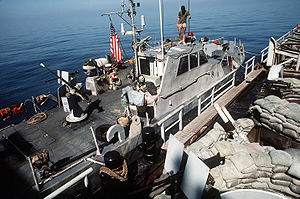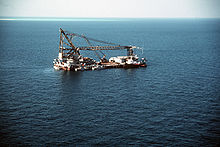- Operation Prime Chance
-
Operation Prime Chance Part of Iran–Iraq War 
A U.S. Navy crewman stands atop the cabin of a PB Mark III patrol boat tied up to the oil rig service barge Wimbrown VII in the northern Persian Gulf. From lower to upper right, the barge is armed with a .50-caliber M2 machine gun, an 81 mm Mark 2 mortar, and a 40 mm Mk 19 grenade launcher.Date August 1987 – June 1989 Location Persian Gulf Result U.S. Navy victory. Belligerents  United States Special Operations Command
United States Special Operations Command Islamic Republic of Iran Navy
Islamic Republic of Iran NavyCasualties and losses None 5 killed, 26 captured (during raid on Iran Ajr only)[1]
Other parts of the operation are not included in this numberRelated U.S. operations in bold
Kaman 99 – Abadan – 1st Khorramshahr – Morvarid – Dezful – Undeniable Victory – 2nd Khorramshahr – Samen-ol-A'emeh – Jerusalem Way – Jerusalem – Ramadan – Before the Dawn – Dawn 1 – Dawn 2 – Dawn 3 – Dawn 4 – Dawn 5 – Dawn 6 – Marshes – Kheibar – Badr – Al-Anfal Campaign – 1st Al Faw – Dawn 8 – Karbala 4 – Karbala-5 – Karbala-6 – USS Stark Incident – Karbala Ten – Nasr 4 – Earnest Will – Prime Chance – Eager Glacier – Nimble Archer – Halabja – Zafar 7 – 2nd Al Faw – Praying Mantis – Air Flight 655 Incident – Mersad
Operation Prime Chance (August 1987 – June 1989) was a United States Special Operations Command operation intended to protect U.S.-flagged oil tankers from Iranian attack during the Iran–Iraq War. The operation took place roughly at the same time as Operation Earnest Will (July 1987 – December 1988), the largely Navy effort to escort the tankers through the Persian Gulf. The operation was begun after the mining of the U.S.-flagged Kuwaiti oil tanker Bridgeton.Contents
Overview
The two operations were intertwined—United States Army helicopters flew nighttime search-and-destroy missions from Navy frigates and destroyers and from two leased barges in the northern Persian Gulf. Navy SEALs and Explosive Ordnance Disposal operated from the barges as well. But while Earnest Will was the widely publicized reaction to Kuwaiti pleas for help, Prime Chance was secret. The Army helicopters flew at night, slipping to and from Navy flight decks under cover of darkness. The helicopter pilots often flew some 30 feet (9.1 m) above the water, and became the first to use night vision goggles and forward looking infrared devices in combat. Tactics included using MH-6 Little Birds as spotters for the more heavily armed AH-6s (for barge-launched missions), and using the warship's radar and that of their SH-60 Seahawk helicopters for the same purpose (on ship-launched efforts).[2]
Planning
Planning and preparation for Prime Chance was launched soon after a tanker on the very first Earnest Will convoy struck a mine, which made it clear that more forces would be necessary to assure the safety of the civilian vessels. The Joint Chiefs of Staff launched a search for helicopter pilots who could fly at night from Navy ships, then set out to train them for the special requirements of the job. Helicopters from the Army's 160th Special Operations Aviation Regiment (Airborne) reached the Navy's command ship USS La Salle (AGF-3) in the Persian Gulf on 5 August 1987. The detachment was divided into two teams, with call sign SEABAT and one MH-6 Little Bird, two AH-6s, aircrew, and maintainers. On 8 August, one detachment participated in a convoy escort mission aboard La Salle. The other flew onto USS Klakring (FFG-42) to protect minesweepers operating in the narrow shipping channel west of Farsi Island. The following day, the La Salle detachment transferred to USS Jarrett (FFG-33) and escorted the convoy to the Gulf of Oman.
As operations continued, the detachments of two aircraft kept moving from Frigate to Frigate in order to remain unpredictable. One crewman of such a Frigate (the author of this edit) found it amusing that the detachments are described as having aircrew and maintainers. In truth, each aircraft had a pilot and co-pilot plus there was only one maintenance Sargent who was responsible for the maintenance of both aircraft. The reason this is amusing is that the Sargent had four assistants, the pilots and co-pilots themselves, and the fact that these assistants were officers meant little to him. When he barked, they jumped. Since their own lives depended on ensuring that the aircraft were in perfect operating condition, they were very happy to do exactly as he told them to.[2]
Execution
Soon afterward, operations began from the barges, dubbed Mobile Sea Bases (MSBs). They were set up as Naval Special Warfare Task Units (NSWTU) run by a SEAL commander and answering to the regional Naval Special Warfare Task Group. Their mission was to stop Iranian forces from mining the Persian Gulf or otherwise attacking shipping. Each mobile sea base had two detachments of Mark III patrol boats, a SEAL platoon, an EOD detachment, Marines to provide security, Army MH-6 and AH-6 Little Bird helicopter gunships and Black Hawk rescue birds, and Air Force combat controllers. Mobile Sea Base Hercules was manned by East Coast Naval Special Warfare units, including Patrol Boats 777 and 758 from Special Boat Unit 20 and Special Boat Unit 24. Mobile Sea Base Wimbrown 7 was manned by West Coast units, including Patrol Boats 753 and 757 from Special Boat Unit 13 and Patrol Boats 775 and 776 from Special Boat Unit 12.[3]
The operation's most dramatic engagement was likely the 21 September 1987, attack on the Iran Ajr, an Iranian ship converted for use as a minelayer. Using night-vision devices, Army gunship crews watched the Iranian vessel lay several mines, then swooped in firing miniguns and rockets. A SEAL team boarded the vessel and quickly seized it. During the attack, five Iranians were killed and 26 were captured. Several Iranian sailors were rescued from the waters of the Persian Gulf after jumping overboard during the attack. After collecting intelligence data the SEALs and EOD scuttled the vessel the following day.[4]
In January 1988, Task Force 118 arrived with OH-58D Kiowa Warrior helicopters.
Earnest Will ended about five months after the Iran-Iraq ceasefire began in July 1988. Wimbrown 7 soon returned to port, but Prime Chance patrols continued from Hercules until June 1989.[3]
Units
Units involved in Prime Chance include:
- 160th Special Operations Aviation Regiment (Airborne), AKA the "Night Stalkers", the Army's elite special-operations flight squadron
- Task Force 118, a regular army aviation unit flying AH-58D Warrior helicopters whose mast mounted IR sights helped spot small boats. In 1990, the unit became 4th Squadron, 17th Cavalry Regiment, and then, in 1994, it became 4th Squadron, 2d Armored Cavalry Regiment[5]
- Mobile Sea Base Hercules and Wimbrown 7, barges leased from an oil company for use by SEALs, EOD, Navy small-boat crews, and Army helicopters
- USS Deyo (DD-989)[6]
- USS Jarrett (FFG-33)
- USS John A. Moore (FFG-19)
- USS Fahrion (FFG-22)
- USS Klakring (FFG-42)
- USS La Salle (AGF-3)
- USS Gallery (FFG-26)
- USS Samuel B. Roberts (FFG-58)
- USS Copeland (FFG-25)
- USS Okinawa (LPH-3)
- SEAL Team 1
- SEAL Team 2
- EOD Mobile Unit Five
- EOD Mobile Unit Six
- Special Boat Unit 12
- Special Boat Unit 13
- Special Boat Unit 20
- Special Boat Unit 24
- Detachment form 1st Battalion 5th Marines
- 3/4 ADAR, 82nd Airborne Division. Vulcan crews provided surface defense.
- 174th Military Intelligence Company, 513th Military Intelligence Brigade, provided intelligence to Wimbrown 7
References
- ^ "Caught In The Act" TIME. 5 October 1987.
- ^ a b "Night Stalker History – Operations Earnest Will and Prime Chance". Nightstalkers.com. http://www.nightstalkers.com/history/4.html. Retrieved 19 May 2011.
- ^ a b "The History of the boats in the Persian Gulf". Warboats.org. http://www.warboats.org/persiangulf.htm. Retrieved 19 May 2011.
- ^ "NO HIGHER HONOR: Photos: Capture of the Iran Ajr". Navybook.com. http://www.navybook.com/nohigherhonor/pic-iranajr.shtml. Retrieved 19 May 2011.
- ^ 160th Special Operations Aviation Regiment (Airborne)[dead link]
- ^ Bell AH-58D Prime Chance Kiowa Warrior Helicopter Photos[dead link]
Further reading
- Crist, David B. (Autumn/Winter 2001–2002). "Joint Special Operations in Support of Earnest Will" (PDF). Joint Force Quarterly (29): 15–22. ISSN 1070-0692. http://www.dtic.mil/doctrine/jel/jfq_pubs/0629.pdf. Retrieved 22 July 2009.
- Kelley, Stephen Andrew (June 2007). Better Lucky than Good: Operation Earnest Will as Gunboat Diplomacy. Monterey, Calif.: Naval Postgraduate School. OCLC 156993037. http://www.ccc.nps.navy.mil/research/theses/kelley07.pdf. Thesis paper.
- Magnuson, Ed (19 October 1987). "We Engaged". TIME. http://www.time.com/time/magazine/article/0,9171,965751-1,00.html. Retrieved 22 July 2009. About the "Battle of Farsi Island" engagements of early October 1987.
- Partin, John W.; U.S. Special Operations Command (April 1998). Special Operations Forces in Operation EARNEST WILL/PRIME CHANCE I. MacDill AFB, Fla.: U.S. Special Operations Command, History and Research Office. OCLC 39138636.
- Peniston, Bradley (2006). No Higher Honor: Saving the USS Samuel B. Roberts in the Persian Gulf. Annapolis, Md.: Naval Institute Press. ISBN 1-59114-661-5. http://www.navybook.com/nohigherhonor. (Briefly discusses TF118 operations from a U.S. Navy frigate)
- Stubblefield, Gary; Hans Halberstadt (1995). Inside the Navy Seals. Osceola, Wis.: Motorbooks International. ISBN 0760301786.
- Wikul, Commander Peter I. (1995). "Mobile Sea Base Hercules In The Northern Persian Gulf: Beirut Barracks II?". United States Navy; Globalsecurity.org (reprint). http://www.globalsecurity.org/military/library/report/1995/WPI.htm. Retrieved 23 July 2009.
- Wise, Harold Lee (2007). Inside the Danger Zone: The U.S. Military in the Persian Gulf 1987–88. Annapolis, Md.: Naval Institute Press. ISBN 1-59114-970-3. http://www.insidethedangerzone.com.
External links
Categories:- Conflicts in 1987
- Conflicts in 1988
- Conflicts in 1989
- Military history of the United States (1900–1999)
- Operations involving American special forces
- Military operations involving the United States
- Iran–United States relations
- Military operations of the Iran–Iraq War
- Naval battles of the Iran–Iraq War involving the United States
- United States Marine Corps in the 20th century
Wikimedia Foundation. 2010.

